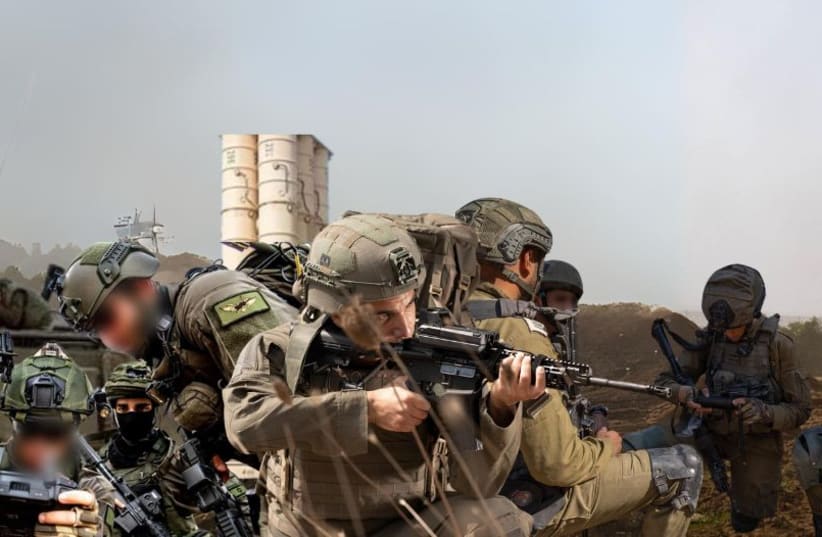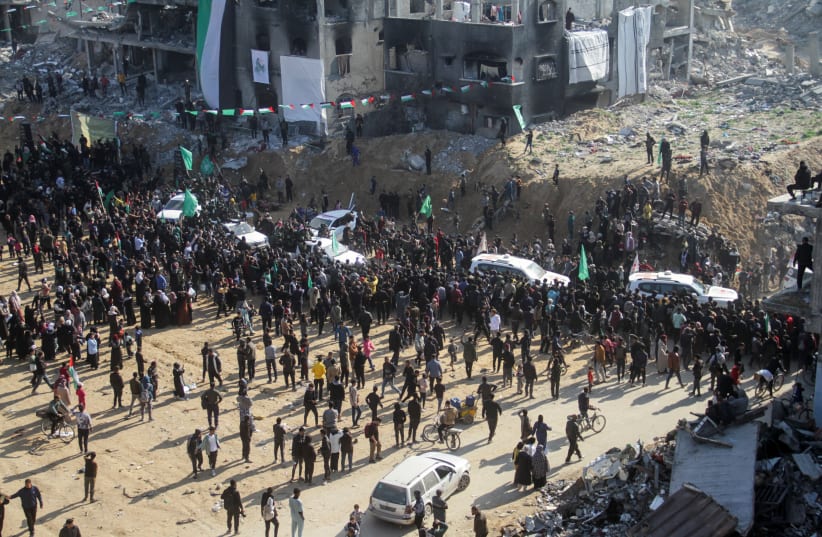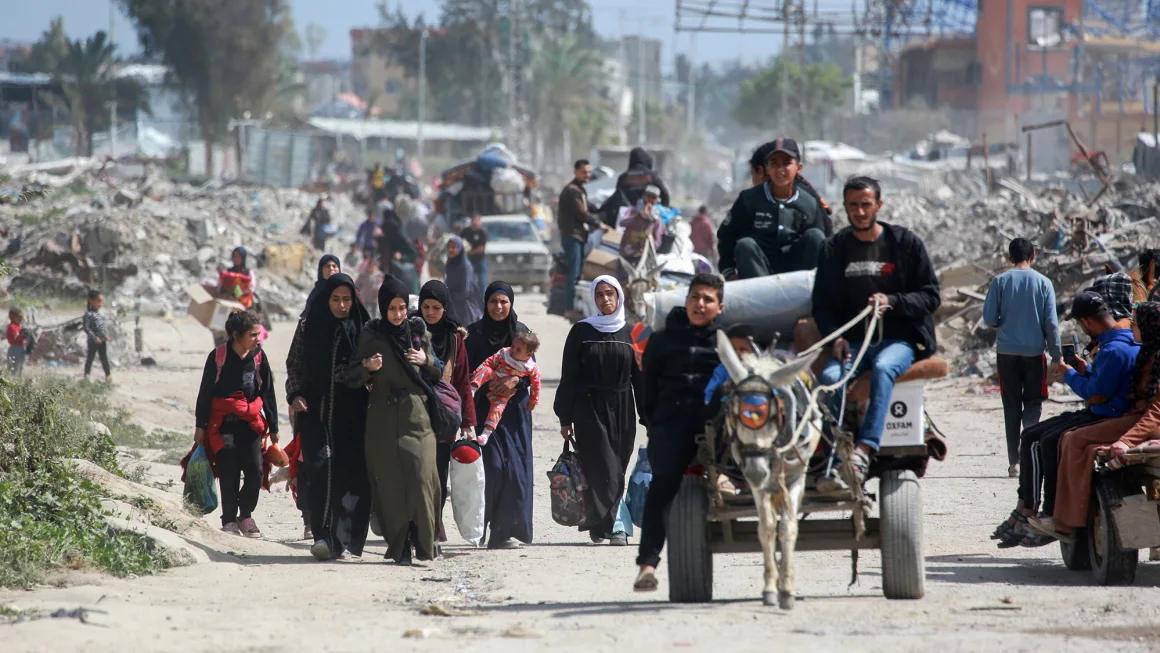Foreign
One hundred days of innovation: The IDF’s new weapons, tactics and units in Hamas War

During the first 100 days of the Israel-Hamas War, the IDF has had to adjust to the demands of a ground offensive that has led them deeper and deeper into the heart of Gaza.

War is never stationary. Even if it appears that advances on the battlefield are slow, processes behind the scenes can lead to innovations in military tactics, weapons, vehicles, and even the structure of military units.

During the first 100 days of the Israel-Hamas War, the IDF has had to adjust to the demands of a ground offensive that has led them deeper and deeper into the heart of Gaza.
Now, the IDF has revealed some of its innovative accomplishments over the first three months of the war. These encompass all forms of IDF warfare: at sea, on land, and in the air, and both in regular and reserve duty.
Medical innovations that save lives – even in the depth of the Strip
In recent weeks, Medical Corps personnel have introduced a variety of new medical capabilities tailored to the nature of field combat and changing conditions. IDF Medical Corps medics and paramedics accompanying soldiers inside the Gaza Strip will include 60,000 doses of whole blood sacks in their equipment.
Whole blood refers to a special type of blood consisting of red blood cells, white blood cells, and platelets suspended in plasma. Most patients receiving transfusions do not need all of these elements. However, it can make a huge difference when treating wounded troops on the battlefield.
Latest weaponry used in Gaza
In the depths of Gaza and in the most crowded places, new combat measures have come into use – the Iron Sting mortar, the ‘Ido’ night vision goggles, ‘Holit’ shoulder-fired missiles, and more. IDF soldiers are using them for the first time during this conflict, and a huge effort is being made to integrate them into all necessary combat units.
‘Iron Sting’ mortar: The precision “Iron Sting” mortar entered operational use for the first time in October, as the IDF’s Maglan unit used the innovative weapon to target Hamas’s rocket launchers in the Gaza Strip. The 120 mm. mortar has increased accuracy and is for use against terrorists in crowded areas, helping troops avoid collateral damage. It is guided with the help of a laser and GPS.
‘Holit’ and ‘Yated’ shoulder-fired Missiles: The new ‘Holit’ and ‘Yated’ are the latest weapons to be introduced to ground troops. These shoulder-fired missiles have longer firing ranges, with a 50% increase in size compared to their predecessors. A multi-stage activation mechanism also makes them safer to use. These new shoulder-fired missiles are designed for fighting in the dense, heavily built-up areas of Gaza.
‘Ido’ Night Vision goggles:
For the first time, IDF reconnaissance units operating in Gaza have renewed their night vision capabilities with a device that provides a three-dimensional image. The ‘Ido,’ used by soldiers for night vision, enhances visibility over time and helps them navigate in the area from dusk until dawn.
The ‘Ido’ is modular and can be efficiently assembled on the front of the soldier’s helmet. It can be used for dual-eye or single-eye vision, aiding the soldier even in completely closed and pitch-black spaces.
Divisions and units operating for the first time in Gaza
For the first time since 2005, the IDF’s Kfir Infantry Brigade is operating in the Gaza Strip. Additionally, the IDF’s 5th Reserve Division and Multidimensional Unit (Unit 888 “Refaim”) are operating in Gaza for the first time. Forces are fighting against Hamas terrorists, locating and destroying the underground tunnels of the terror organization. In addition, for the first time, the Caracal combined unit of both male and female soldiers is operating in the Strip.
First operational use of ‘Arrow 3’ missile system
On October 31, a surface-to-surface missile launched into Israeli territory from the Red Sea by Yemen’s Houthis was successfully intercepted by the new “Arrow (Hetz) 3” long-range defense system, entering its first operational use. The IAF’s use of the “Arrow 3” air defense system came on the heels of the first successful use of the ‘Arrow 2’ system in early November, which allegedly marked the first-ever instance of combat outside Earth’s atmosphere. The “Arrow 3” system, developed by Israel Aerospace Industries, a leading defense firm, is the advanced air defense system for intercepting ballistic missiles in space.
‘Dumb bombs’ used for first time in operational activity
As part of the fighting in the Gaza Strip, the Adir fighter jet 140 Squadron (Golden Eagle) and Squadron 116 (“Southern Lions”), carried out attacks for the first time using “dumb” (unguided) bombs of the Joint Direct Attack Munition (JDAM) system attached to the wings of the planes. Israel is the first country in the world to use them in operational activity.
This is a significant improvement to the attack capabilities of the formidable Adir, with the goal being more attacks in fewer flights. Until today, the Adir jets carried munitions inside the plane, but today they can carry a greater number of weapons, using several types of bombs, which allows flexibility and adaptability to reduce several missions in one sortie.
SMASH fire control system changing the battlefield
Weighing less than its predecessors, the SMASH firing system identifies an enemy within seconds and can lock onto targets and assist in their elimination. The SMASH fire control system entered the battlefield in its new form during the Gaza War and can improve the chances of hitting an enemy fourfold
“The fire monitoring system Smash has been introduced to the battlefield during the war against Hamas. This operational support tool weighs less than standard sights, identifies the enemy within seconds, can lock on targets, and quadruples our forces’ chances of hitting their target,” said the IDF.
‘Saar 6’ battleships attack Gaza
Cutting-edge Saar 6 battleships were used in October to attack Gaza for the first time. Attacks from the Oz and Magan Saar 6 ships struck Hamas infrastructure for assembling weapons as well as positions and lookout posts for the Hamas naval commandos. The naval vessels have 18 different advanced technological and precision combat systems onboard, much of which was developed in Israel, and three of them have become fully operational over the last six months.
The ships also operated for the first time in the Red Sea as part of an enhanced defense effort. One of the ships docked for the first time in Eilat, joining the operational activities of the Navy after sailing in the Red Sea.
LOTAR forces join the offensive
Counter-terrorism special unit LOTAR joined the ground offensive in Gaza for the first time during this war. Along with professional training of the infantry forces and the special units in all areas of the fight against terrorism, they now also take part in specific operational activities in Gaza. Now, for the first time, their squadron is fighting in the Gaza Strip and performing missions at the front of the force.
LOTAR squads have been employing their infiltration, sabotage, and sniping capabilities during operations, including in December, when a LOTAR combat team operating in the north Gazan city of Beit Hanun eliminated several Hamas terrorists during an ambush and demolished tunnel shafts.
New mixed battalion of female soldiers and search and rescue
During the ground maneuver of the campaign, soldiers from the Search and Rescue Brigade are being integrated together with other military units on the ground, such as the Commando Brigade or Nahal, and units such as Oketz, with the aim of hitting Hamas infrastructure, eliminating terrorists and locating weapons and tunnels.
Although Search and Rescue units have been deployed in Israel’s military operations in the past, this is the first large scale use of the troops, and estimates state that 40% of the unit inside Gaza is made up of female soldiers.
‘Negev’ gun in use for first time
The IDF introduced for operational use in Gaza the IWI Negev 7, a gas-operated machine gun. The Negev, which uses 7.62mm caliber bullets, offers superior wall and rubble penetration, which has become a main feature in the fight against Hamas in the heavily built up civilian areas of Gaza.
The upgraded Negev also features a projectile aim for precision in single-shot mode.
All air defense systems operated together to defend Israeli civilians
When over 3,000 missiles were launched toward Israel in the first four hours of the war, all Israeli air defense systems operated at full force without pause. Since then, and during the ongoing three months of conflict, they have made history, with all four systems operating simultaneously for the first time.
These are the Patriot, Arrow, Iron Dome, and David’s Sling.
After the events of October 7 and the huge call-up of reservists, the IDF introduced a new reserve brigade – the “Hashomer” (Guardian) Brigade (855), which consists of reservists from a variety of units and focuses not on maneuvering or attacking but on the task of protecting the Gaza border settlements.
“While a significant part of the army is these days focusing on fighting Hamas and the terrorist organizations in Gaza and attacking inside and across the Gaza Strip, the IDF needs additional forces that will be specialists in defense,” stated Col. Eyal Russo, the commander of the brigade when it launched. “The purpose of the brigade is to allow flexibility to other units, with the aim that they can fulfill their operational tasks.”
New battle rations for warriors in the field
During the war, one new item was added to the food kits – “Bread of Knights” – a Biblical reference to the manna that fell from heaven. Consisting of a package intended for four soldiers to share, it contains, among other things, a hot dish, small personal soups for each soldier, tortillas, salty and sweet snacks, tahini, sauces, breakfast cereals, pastries, coffee, tea, and sugar.
A new tank unit in the Armored Corps – “The Phoenix”
A new unit of tanks was added to the Armored Corps during the course of the war – the “Phoenix.” Due to the growing demand for tank warfare within Gaza, the Phoenix unit was originally intended to back up tanks that had already entered Gaza, but Phoenix tanks have since been sent into the Strip, too, adding extra firepower.

Foreign
Hamas claims spokesperson killed in Israeli strike on northern Gaza

Earlier this week, Israel killed Ismail Barhoum, a member of Hamas’ political office, and Salah al-Bardaweel, another senior leader.

Hamas spokesman Abdel Latif al-Qanou was allegedly killed in an Israeli airstrike on northern Gaza, Hamas-affiliated news agency Shehab reported on Wednesday night.

Al-Qanoa was one of Hamas’s most prominent spokesmen in Gaza, and while he avoided media appearances during the months of fighting, he gave multiple interviews to Arab news channels after the ceasefire.
Al-Qanoua was killed when his tent was targeted in Jabaliya, the Hamas-run Al-Aqsa television reported. The same strike wounded several people, medical sources said.
Earlier this week, Israel killed Ismail Barhoum, a member of Hamas’ political office, and Salah al-Bardaweel, another senior leader.
Both Bardaweel and Barhoum were members of the 20-member Hamas decision-making body, the political office, 11 of whom have been killed since the start of the war in late 2023, according to Hamas sources.
Tents for Palestinians seeking refuge are set up on the grounds of a United Nations Relief and Works Agency for Palestine Refugees (UNRWA) centre in Khan Yunis in the southern Gaza Strip on October 19, 2023, amid the ongoing battles between Israel and the Palestinian group Hamas (credit: MAHMUD HAMS/AFP via Getty Images)
The IDF has yet to comment on the alleged elimination.
Increased IDF pressure in the Gaza Strip
Since fighting in Gaza was renewed at the beginning of last week, the IDF has killed 150 terrorists, including 10 top Hamas officials, The Jerusalem Post learned Tuesday.
In certain areas, the military has entered a full kilometer into Gaza, such as around the Nitzanim Corridor in central Gaza.
In addition to central Gaza, Beit Lahia, Beit Hanoun, parts of Khan Yunis, Shaboura, and Tel Sultan, the IDF has been evacuating and moving into Jabaliya.

Foreign
Dead Nigerians, Africans, others without will may lose unclaimed estates in UK

Hundreds of unclaimed estates reveal untold stories of African migration, wealth, and family ties left behind.
Thousands of people die every year in the United Kingdom without leaving a will or identifying next of kin, and among them are many Nigerians and other Africans whose estates—ranging from property to savings—remain unclaimed.
The UK government’s latest list of unclaimed estates, updated daily, includes over 170 entries connected to African-born individuals, with Nigerians making up a significant portion of the cases.

A Legacy Lost
For many migrants, the UK became a home away from home—a land of opportunity where they built wealth, purchased property, and created a life.

However, the absence of a will often results in their assets being classified as “bona vacantia” (ownerless goods), leaving them to the custody of the Crown.
Families back in Africa are frequently unaware of these estates, leading to a permanent loss of assets.
Cases like that of Adenike Adebiyi, who passed away in Hackney, London, in 2004, or Solomon Adekanmibi, who died in Colchester, Essex, in 2021, highlight the consequences of dying intestate.
With no identified next of kin or missing documentation, their estates remain unclaimed, and their legacies risk being forgotten.
Why It Matters
This phenomenon underscores a critical issue: many African families are unaware of their relatives’ financial situations abroad.
Migration often disrupts communication, and without clear documentation, the wealth built overseas remains beyond reach.
The loss isn’t just financial—it’s deeply cultural and emotional. Unclaimed estates represent untold family histories, connections, and the struggles of migrants who built their lives in the diaspora.
The Challenges
Lack of Awareness:
Most families in Nigeria and other African countries are unaware of their relatives’ estates abroad or how to access them.
Genealogical Gaps:
The information provided in official records is often incomplete. For example, many entries in the UK unclaimed estates list lack detailed family history or next-of-kin information.
Cultural Hesitations:
In many African cultures, discussing death and wills is considered taboo, leading to reluctance in planning for asset distribution.
A Call to Action
African governments, community organizations, and legal professionals need to raise awareness about this issue.
Here’s what can be done:
Encouraging Will Writing: Migrants in the diaspora should be educated about the importance of drafting wills to protect their assets.
Genealogical Support: Families in Africa can be assisted in tracing unclaimed estates through local or international partnerships.
Public Awareness Campaigns: Social and traditional media can highlight the importance of estate planning and share resources for families.
How to Check the List
The UK government maintains a public Unclaimed Estates List that is updated daily.
Families can search the list by name, place of birth, or other identifiers to check for potential claims.
Final Thoughts
For many Nigerians and Africans in the UK, their unclaimed estates represent more than just wealth—it’s a story of migration, resilience, and identity.
By addressing this growing issue, families can reclaim their heritage, and the legacy of those who journeyed to the diaspora need not be forgotten.
Here is the latest daily update as of March 24, 2025. Check the list

Foreign
Israel approves controversial proposal to facilitate emigration of Palestinians from Gaza

Israel’s security cabinet has approved a controversial proposal to facilitate Palestinian emigration from Gaza, a move critics warn could amount to ethnic cleansing.

Israeli Finance Minister Bezalel Smotrich on Sunday said the security cabinet approved the proposal by Defense Minister Israel Katz to organize “a voluntary transfer for Gaza residents who express interest in moving to third countries, in accordance with Israeli and international law, and following the vision of US President Donald Trump.”

The decision marks a remarkable endorsement of a plan once considered a far-right fantasy – and comes despite the prime minister’s earlier pledge not to permanently displace Gaza’s civilian population.
Critics have said that any mass displacement of Gazans in the midst of a devastating war would amount to ethnic cleansing, an act associated with war crimes and crimes against humanity under international law. Israeli officials have countered that emigration would be voluntary and in line with international legal standards.
But aid groups argue that Israel’s war has made life in Gaza nearly impossible. Martin Griffiths, the United Nations’ top emergency relief official, has called the enclave “uninhabitable,” saying its people are “witnessing daily threats to their very existence.”
The Israeli approval would establish an administration within the defense ministry “to prepare and facilitate the safe and controlled movement of Gaza residents who wish to voluntarily move to third countries,” according to a statement from the defense ministry.
Its work would include “establishing movement routes, pedestrian checks at designated crossings in the Gaza Strip,” and infrastructure to enable people to leave.
Israeli officials have presented the plan as a fulfillment of a desire by Trump to take over Gaza, expel its Palestinian population to neighboring countries and turn it into a Middle Eastern “riviera.”
The Palestinian Authority’s Minister of State for Foreign Affairs Varsen Aghabekian Shaheen told CNN’s Becky Anderson last month that Palestinians “are steadfast to stay in their land and will not move.”
Trump’s ‘vision’
Katz said Sunday that Israel is using “all means to implement the vision of the US president,” according to the defense ministry statement.
This month, Trump appeared to backtrack on his comments about displacing Palestinians, telling reporters that “nobody is expelling any Palestinians.” Steve Witkoff, the US special envoy to the Middle East, said last month that the US initiative to rebuild Gaza won’t necessarily amount to an “eviction plan” and that it was designed to “shake up everybody’s thinking.”
Last year, Israeli Prime Minister Benjamin Netanyahu said his country had no intention to displace Palestinians or occupy Gaza.
Related articleTrump says ‘nobody is expelling Palestinians,’ weeks after saying they should be moved to Arab states
“I want to make a few points absolutely clear: Israel has no intention of permanently occupying Gaza or displacing its civilian population,” Netanyahu said in a video statement in January 2024.
Trump’s proposal has, however, brought the idea further into the mainstream, with Israeli politicians now openly discussing mass emigration of Gazans as a solution to the war. And Katz last week said that Israel may maintain a permanent presence in the enclave.
Israeli rights group Peace Now criticized the plan, saying “the establishment of the administration to expel Palestinians from Gaza is one of the stupidest moves by a government that has lost all direction and logical thinking.”
The prospect has also drawn sharp rebuke from Arab leaders, especially Egypt and Jordan, who would be expected to absorb the large number of expelled Palestinians. Experts have also warned that displacing Palestinians would further destabilize the region and threaten the security of neighboring states.
Smotrich said Sunday that the security cabinet also approved the expansion of Jewish settlements in the occupied West Bank, noting that 13 areas in the West Bank would be split from existing settlements and would be recognized as independent settlements.
“Instead of hiding and apologizing – we are raising the flag, building, and settling. This is another important step on the path to actual sovereignty in Judea and Samaria,” he said, using the name by which Israelis refer to the West Bank.
The Yesha Council, an umbrella body representing Jewish settlements, said that as of January 2024, there were 150 settlements in the West Bank.
It said that the decision exposes a “long-standing lie that (Israel) does not establish new settlements, but only ‘neighborhoods’ of existing settlements” and that it is “another nail in the coffin that the Government of Israel is preparing for the only chance for a future of peace and security.”
A statement sent by Smotrich’s office said the move comes against “the backdrop of the approval of tens of thousands of housing units in Judea and Samaria and represents another significant step in the process of normalizing and regulating the settlement.”
Smotrich and other right-wing ministers have been pushing an aggressive expansion of settlements on the path to declaring Israeli sovereignty over the West Bank, which would be in defiance of international law and UN Security Council resolutions.
Israel says it will maintain ‘permanent’ presence in Gaza unless hostages are freed

-

 Foreign1 week ago
Foreign1 week agoHouthis declare Ben-Gurion Airport ‘no longer safe’ after renewed Gaza fighting
-

 News1 week ago
News1 week agoWhy Christ Embassy’s Pastor Chris holds Abuja mega crusade – Fisho
-

 News1 week ago
News1 week agoUmeh denies receiving $10,000 with other 42 Senators to support state of emergency in Rivers
-

 Crime1 week ago
Crime1 week agoGhana’s anti-drug agency nabs Nigerian drug kingpin, Uchechukwu Chima, seizes $2.1m worth of cocaine, heroin
-

 News1 day ago
News1 day agoKogi Governor, Ahmed Usman Ododo salutes Tinubu at 74
-

 Business1 week ago
Business1 week agoFlutterwave, FIRS collaborate to digitize tax collection in Nigeria
-

 News1 day ago
News1 day agoAkpabio pays historic visit to office of SA to President on Senate Matters
-

 News6 days ago
News6 days agoAgain, explosion rocks gas facility in Rivers




















